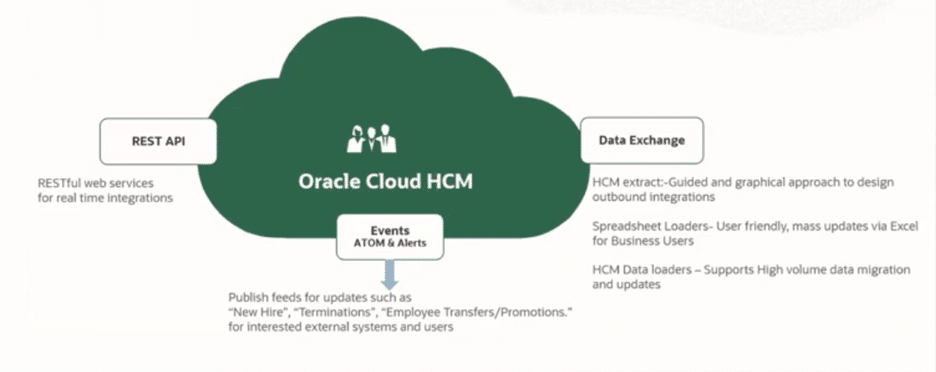Oracle Cloud HCM Integrations: How are third party vendors and agencies handled?
-
Posted by Quest Customer Learning Team
- Last updated 11/29/23
- Share

Oracle Cloud HCM Integrations: How are 3rd party vendors and agencies handled?
The Oracle Cloud HCM integrations strategy takes a 2-prong approach: delivered integrations and delivered tools.
Delivered Integrations are integrations designed, built and maintained by Oracle and partners. Delivered Tools are standards-based APIs and visual tools to configure your own integrations.
The biggest advantage from a Cloud perspective is the ability to identify use cases based on the customer’s adoption, type of partner, and type of system being used. Delivered integrations simplify most integration problems. They are designed and maintained by Oracle. In Oracle development, the Cloud government team works directly with partners to maintain these solutions.
There are integrations for a fleet of services provided by Oracle. These integrations are provided as part of the solution when you subscribe to Cloud HCM. In most cases, it’s at zero additional cost.
For needs not met by the delivered integrations, there are delivered tools.
It’s common for customers who are running Cloud to use both delivered integrations and delivered tools. Furthermore, customers often use delivered capabilities to create their own integrations.
Delivered Integrations: Payroll

There are delivered Cloud HCM integrations for several of the payroll solutions. A handful are listed below:
- ADP Globalview & Streamline
- ADP Workforce Now (US/CA)
- Celergo Global Payroll
- NGA Payroll Interface
If you’re using any of these providers, you can take the delivered interface to these providers, and it will get you to 95–98% in terms of the data elements needed. The rest will be taken care of when you configure according to your business. It’s an extendible approach.
Because it’s impossible to provide integrations for every single provider on the market, Oracle developed a central solution called the Oracle HCM Global Payroll Interface to connect to any provider. You can use this as a starting point that gets you to the 80–90% range in terms of developments needed for those providers. You’ll add the remaining needed from a translation perspective and do the transmission.
Most customers who transition to Cloud core capabilities move to payroll at the same time. From there, they make incremental moves toward other modules.
Delivered Integrations: Benefits

As with Payroll, there is a standard interface provided by Oracle for Benefits, instead of individualized solutions for the 500+ services on the market. This standard interface works with two aggregators which perform translations for the end career format.
Oracle works directly with Known2U and Benefits XML to keep the interface updated. In turn, the providers have the responsibility to update all translations to careers.
Customers who choose one of these providers are charged based on the number of careers. This is very cost effective for most customers.
Some customers choose to do the translation themselves. In this case, the customer takes the standard benefit interface provided and does their translations to individual career formats using integration tools provided.
More Delivered Integrations in Cloud HCM
Time & Labor
There are third party Cloud HCM integrations for time collection devices and advanced scheduling. These include but are not limited to Accu-Time Systems, Workforce Software, Kaba Time Collection, and TimeClock Plus from Humanity. The integrations go through REST APIs to connect to Oracle Cloud HCM.
Learning
It’s typical to use third party services for online content providers and video content providers. There are integrations to these so that administrators can use them from within the Oracle solution. They are considered direct providers. Popular providers include Skillsoft, Zoom, Adobe Connect, and Webex.
Recruiting
For profile import, there are major delivered integrations for Indeed and LinkedIn. Candidates can apply using their profiles, making it advantageous and time-efficient for both candidates and hiring managers.
Additionally, there are 50+ partners for job distribution, background checks, video interviews, SMS Gateway, and WOTC.
Cloud HCM Native Tools
Cloud HCM Native tools are modern, API-based, and event driven. They were designed to support key integration patterns and user personas.
With a standards-based API, there is access to key business objects.
As for data exchange, data from bulk or data migration is supported in very high volume. End-user based uploads are business user-friendly through mass update via Excel. HCM Extract guides users through design outbound integrations.
Events ATOM and alerts allow published feeds for updates such as New Hire, Terminations, Employee Transfers/Promotions, etc., for interested external systems and users.
Below is a snapshot of the toolsets that have been delivered:

The following image shows a deeper level for Oracle Cloud HCM Integrations and Oracle Integration Cloud:

Objects allow customers to add their attributes and extend them. The top layer of toolsets means you don’t just have the ability to take static fields—you can define extensions to objects and then use the toolsets. All of these are HCM Cloud native tool sets with native capabilities.
All native capabilities can work with any platform integration service on the market.
Cloud HCM Integrations Key Takeaways
Most Cloud HCM customers apply a hybrid strategy when it comes to their digital transformation. Customers use a combination of native toolsets alongside an integration hub. The hub can be the Oracle integration hub, but it doesn’t have to be.
For more information, check out the Oracle webinar: PeopleSoft and Cloud Applications Webinar Series: Third Party Integrations in Oracle Cloud HCM.
For related content, check out the Move to Cloud and Cloud HCM content in the Quest Learn Library.
To connect with other customers considering a move to the Cloud HCM, consider joining the Move to Cloud for PeopleSoft special interest group.
